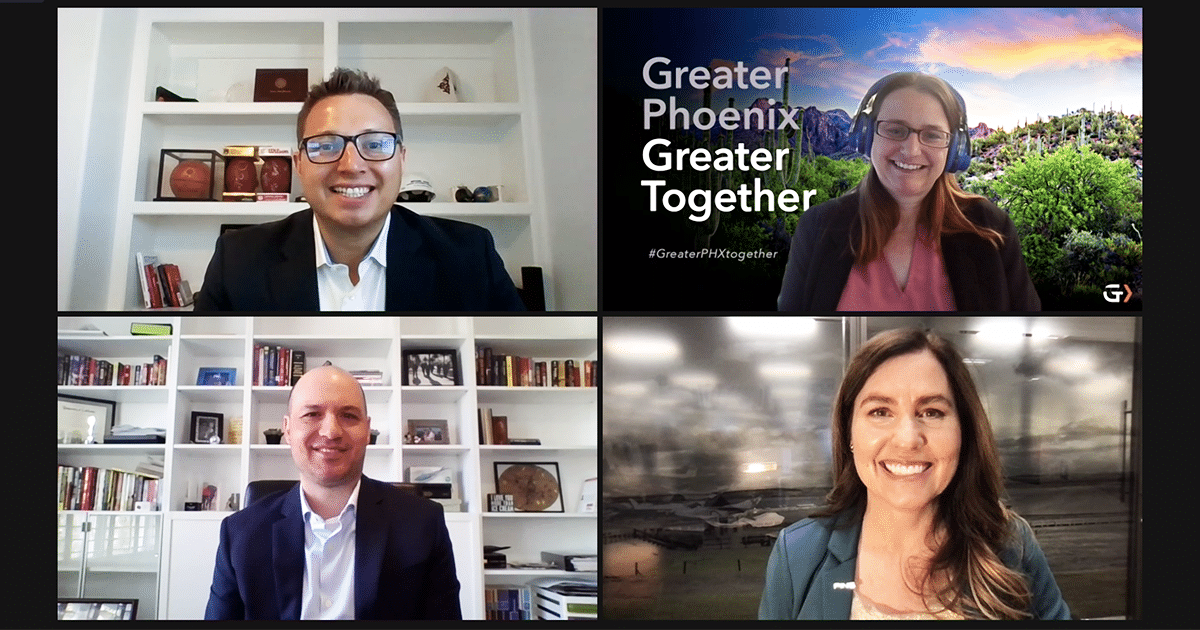

Ambassador Event: Modern Manufacturing
Published: 03/24/2021
Updated: 04/11/2024
Manufacturing advancement in Greater Phoenix
The rapid evolution of technology is driving the advancement of manufacturing. Greater Phoenix is situated to be a leader in this sector.
Two local companies joined GPEC’s latest Ambassador Event to discuss trends, the diversification of supply chains in the region and how Greater Phoenix has emerged as an ideal place for operations.
Panelists included:
- Tony Bregante, chief financial officer, RJR Technologies
- Dawn Grove, corporate counsel, Karsten Manufacturing (PING)
- Kristen Stephenson, senior vice president of research & analytics, Greater Phoenix Economic Council
- Moderator: Mitchel Allen, senior vice president of business development, Greater Phoenix Economic Council
Growth of the manufacturing industry
As manufacturing becomes more sophisticated, Stephenson said, companies are experiencing a greater need for skilled labor. This goes a step beyond traditional manufacturing operations. The fastest growing occupations include data science, information technology and software.
“In the last decade … we have put technology into every station of our manufacturing plant,” Grove said. “We’ve actually embedded interactive technology into the golf clubs themselves.”
With greater technology comes the expectation for perfection.
“Electronics is one of the few industries where there’s a built-in expectation to have a better product at a lower cost every year. So every year, we have to innovate,” Bregante said. “For us, it’s been a transformation of having, say, 100 people produce a million units to having 50 people produce 10 million units, all by ways of automation … It’s dramatically changed our shop floor.”
This has created the growing need for more advanced skillsets and talent.
“It is the wave of the future,” Grove said. “At PING, we’re looking at collaborative robots — co-bots — that could work alongside our workers. We need people who will understand that technology, be able to repair that technology, work with it.”
Diversification of supply chain
With the increased demand of speed-to-market, companies have found a need to diversify their supply chain. This can reduce the disruption of the manufacturing process and eliminate some tariff effects on the companies.
Karsten’s main subsidiary is golf powerhouse PING, but it also manufactures precision casting for the railroad, aerospace and mining industries. It exports to nearly 100 companies around the world and uses a variety of local suppliers for many of its goods. These partners include Victory, which makes corrugated boxes for packaging; Industrial Metal Supply, which supplies aluminum steel for machinery; and Tar, which produces hand sanitizer.
The convenience of these factories in one centralized region helps Karsten continue to produce enough output to meet demands.
RJR Technologies moved to Phoenix from San Francisco in 2017. The company, which focuses on intellectual property and adhesives, particularly hermetic packaging used to house microchips for cell phone base stations, found it difficult to locate molders within a three-hour radius of their Bay Area operations hub.
In Greater Phoenix, RJR has found specialists who produce tools and parts that the company needs.
“We have multiple specialists that produce the tools that we use inside of our own factory, and that’s been a big advantage, both in terms of being able to reduce our time to market for new designs, and also as we’re scaling up and running into those issues that you run into when you bring a new product online, to be able to troubleshoot directly with those suppliers within a short car ride,” Bregante said.
Greater Phoenix as a manufacturing hub
Over the last 10 years, 238 manufacturing operations have expanded or relocated to Greater Phoenix. A sizable portion came recently — 38% arrived between 2018 and 2019.
Job growth is anticipated to increase along with the number of companies moving to Arizona. Our latest ‘Industry Insights Report: Manufacturing’ revealed that Greater Phoenix’s competitive position is expected to net more than 5,400 new manufacturing jobs by 2025, significantly outpacing the growth in major western markets. Sixty-five percent of expected job growth in the region is driven by the unique characteristics that make Greater Phoenix competitive, including modern infrastructure.
Bregante said that when RJR Technologies initially analyzed Greater Phoenix as a new home, the infrastructure stood out compared to the Golden State.
“Coming out of California, you always look around and it feels like they’re three years, four years behind whatever’s being demanded,” Bregante said. “We saw the reverse out here. You saw availability, you saw the freeway system, all those kinds of aspects being built in advance, so we don’t have any trepidation in regards to laying out our plans.”
PING has Arizona’s scalability on its mind. This week, Karsten is opening an 80,000 square-foot warehouse that will house the bulk of the company’s manufacturing in the state.
“I know some companies may prefer to locate near a port city … but when you look at the cost of doing business in California, with all of their high taxes and high regulations and lower quality of life, I really think that Arizona has everything over it. You can see why so many manufacturers are leaving California to come to Arizona,” Grove said.
“We’re really fortunate with a lot of the infrastructure and programs that we’ve put in place over the previous years — going back decades, really — that have us set up well for manufacturing in the future,” Stephenson said.
To continue manufacturing development in Greater Phoenix, it is important to continue to advocate for policies relating to pro-business taxes and regulation, clean and renewable energy and the promotion of binational collaboration between Mexico, Greater Phoenix and Southern California.
Additionally, continued investments in statewide infrastructure, transportation and education programs including the New Economy Initiative will be vital.